Genre: Shmup Developer: Sega of Japan Publisher: Sega of America Players: 1 Released: 1988
I’m not sure if you remember the original Sega arcade game, Thunder Blade, but it was awesome back in the late ’80s. The deluxe cabinet was one of those trademark Sega arcade experiences that you would never forget. Just like Space Harrier, Afterburner, and Galaxy Force II, Thunder Blade was just an all-out assault on your senses with vibrating, force feedback controls, some of the sharpest graphics of the era, and some fast, explosive, action packed gameplay that would literally suck the quarters out of your pocket like a vacuum.
Sega ported each of its classic 32-bit “super scaler” arcade games to the 8-bit Master System, and the 16-bit Genesis in one form or another with mixed results, but through the years most of the classic arcade games that the company built its name on in the ’80s have been rereleased in their true forms (or close to it). Shinobi, OutRun, and even Galaxy Force II have each been reborn in one way or another, be it the 32X, as an unlockable in Sonic’s Ultimate Genesis Collection, or the Sega Ages compilations on the Japanese Saturn and PS2. Sadly, Thunder Blade is one of those classic Sega games that has been left behind in the arcades. Super Thunder Blade for the Genesis and its 8-bit little brother on the Master System were the only ports of the arcade game to see a release on a Sega console, and with those ports it was quite obvious that the home video game technology of 1988 was clearly not ready for Thunder Blade.
Even though the Master System port of Thunder Blade doesn’t even come close to replicating the experience of the arcade game, it does have some impressive 3D effects for an 8-bit game. Thunder Blade for the Master System is surprisingly even actually a closer port to the arcade game than its 16 bit “Super” big brother in its level designs, and difficulty. What about the gameplay though? Is Thunder Blade worth hooking up the Power Based Converter for? Let’s “Get to de CHOPPA!” and find out.
Thunder Blade is a helicopter shooter with four levels divided into three zones each. One part of the game is played in a top-down, 2D vertically scrolling view, and the other is a third person 3D perspective from behind the helicopter, much like the view used in the Genesis Super Thunder Blade. The end of each level awaits an enemy fortress as a boss battle. The fortress at the end of the game is damn near impossible to defeat and may cause you to break a few controllers. The vertically-scrolling levels have a weird, choppy feel to them, and a lot of the gameplay elements of the arcade original were cut back, like the ability to fix your speed and change altitude. Your only weapons throughout the game are your standard machine gun and a homing missile that is fired towards the ground. Aside from your boss fortresses at the ends of the levels, you blast at the same enemies through the game which include tanks, jets, and other helicopters. None of the enemies pose any meaningful challenge and mainly just fly at you in formations or shoot at you from the ground.
Another glaring flaw of the top-down levels is the drab look of the scenery and poor use of color. The 3D scaling levels are a valiant attempt at the effect considering the 8-bit hardware, even though the frame rate crawls along at about two frames per second, literally. The order of the levels and the designs are a lot closer to the arcade game than Super Thunder Blade, but the developers didn’t really compensate for the cuts to the gameplay and controls. Other 8-bit ports of Sega arcade games of the era were compensated for their cuts with exclusive gameplay modes (split-screen multi-player in OutRun or new weapons/power-ups Shinobi), but not Thunder Blade. Still, even with all its flaws, it is somewhat impressive considering it is an 8-bit game and indeed quite playable, but it just isn’t as fun as the arcade game and just comes off as a bland shooter.
There is a total of three songs in the game, and only two of them are used during the gameplay. Those two songs aren’t terrible per se, but they do get pretty old quick and add to the overall repetitive nature of the game. The sound effects in the game sound decent. The explosions and the gunfire sound full and loud, and they’re maybe a bit on the annoying side but not really bad though. Moreover, there’s nothing really notable about the music or sound effects of Thunder Blade but nothing really terrible either.
One of the best things that the SMS port of Thunder Blade has going for it is the “game over” screen, which consists of a pretty cool picture of your chopper and the better tune in the game. A charming little 8-bit number that is actually quite memorable, and worth checking out if you enjoy 8-bit music.
Thunder Blade on the Sega Master System just falls way too short of the arcade original. The overall choppy nature of the graphics, and the slow frame rate actually make the game overly difficult. A good 8-bit port of an arcade game doesn’t necessarily have to look just like the real deal if the gameplay still feels the same, but with the SMS port of Thunder Blade, they just made way too many cuts. The inability to change altitude or adjust your speed in the top down levels just make it feel like another generic, boring 2d shooter, but without any fancy power ups, or weapons. In spite of the games shortcomings, Thunder Blade on the Sega Master System is indeed an interesting, playable game at the very least, and makes you question what was so “Super” about its 16-bit upgrade. At the end of the day though, Thunder Blade was a great arcade game that was swept under the rug by Sega. The fact that the Genesis, and Master System ports of the game were so lackluster just makes it a sad situation. I can think of a few other add-ons for the Genesis that Thunder Blade would have been right at home on.
SCORE: 4 out of 10

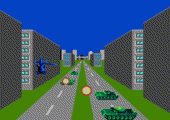
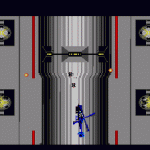
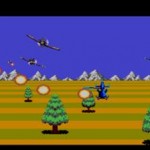
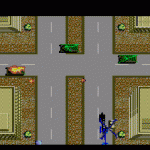
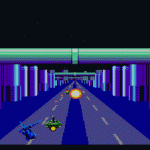
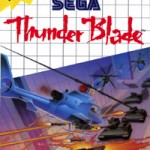
genesis versio is way better
Yeah, he’s right this game pretty much sucks!